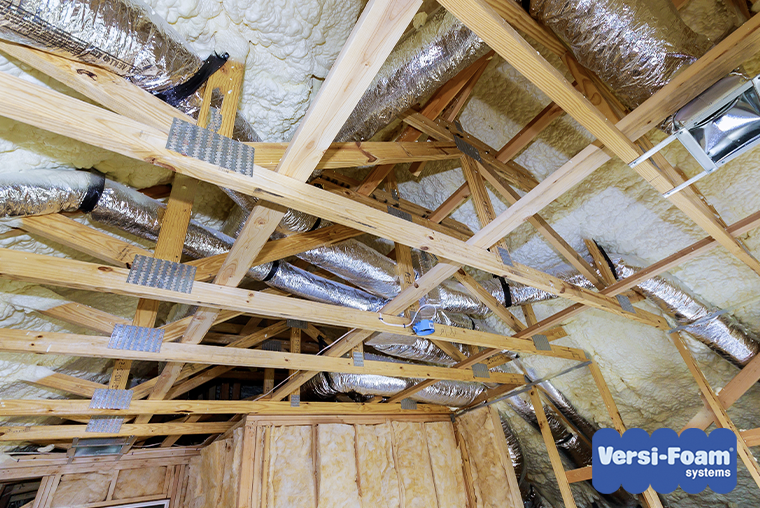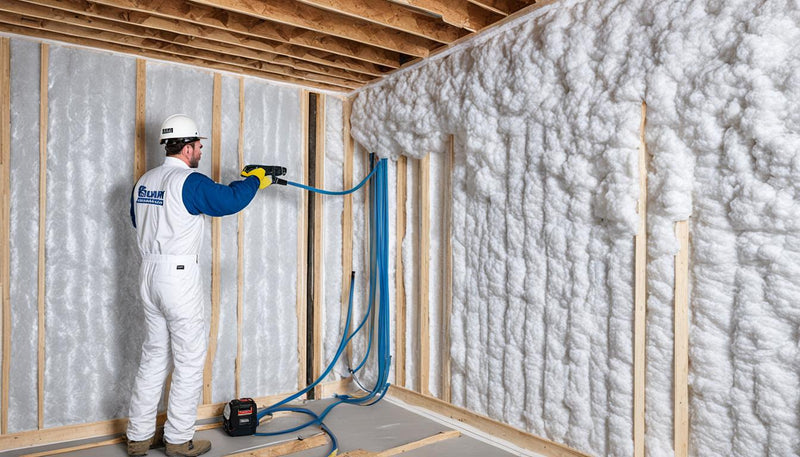Picking the Right Sort Of Spray Foam for Your Insulation Demands
Picking the Right Sort Of Spray Foam for Your Insulation Demands
Blog Article
Spray Foam: The Ultimate Solution for Air Sealing and Insulation
Spray foam insulation has actually emerged as a leading remedy for effective air securing and thermal insulation, using an one-of-a-kind combination of residential or commercial properties that establish it apart from typical methods. Recognizing the complete scope of its advantages, installment procedures, and contrasts with various other insulation types is essential for making educated choices.
What Is Spray Foam?
Spray foam is a functional insulation product that incorporates the concepts of air securing and thermal resistance to improve power performance in structures. Made up mainly of polyurethane or various other comparable substances, spray foam is used as a liquid that expands upon call with surface areas, creating a solid, continuous layer of insulation. This one-of-a-kind building enables it to fill voids, cracks, and spaces that typical insulation materials may neglect, supplying a superior air seal.
There are 2 main types of spray foam: open-cell and closed-cell. Open-cell spray foam is lighter and more versatile, supplying superb audio absorption and a reduced R-value per inch - Spray Foam. In contrast, closed-cell spray foam is denser, giving a greater R-value, wetness resistance, and added architectural stability to constructing components
The application process usually entails specialized devices, guaranteeing a smooth application that follows various substratums, including concrete, wood, and steel. This versatility makes spray foam suitable for both brand-new buildings and retrofitting existing structures. Its capability to create an impermeable obstacle substantially contributes to reducing energy consumption and enhancing indoor air high quality, thereby making it a preferred choice amongst contractors and house owners alike.
Benefits of Spray Foam Insulation
One of the most substantial benefits of spray foam insulation is its remarkable capacity to produce a continuous air barrier, which effectively lessens energy loss. Unlike conventional insulation materials, spray foam broadens to load cracks and voids, making certain that air leak is considerably lowered. This particular not only improves energy performance however likewise brings about reduce utility bills in time.
In addition, spray foam insulation supplies superior thermal resistance, adding to an extra stable indoor atmosphere. Its high R-value per inch enables efficient insulation in restricted areas, making it suitable for attic rooms, walls, and crawl spaces. The moisture-resistant buildings of spray foam help avoid mold and mold development, advertising much healthier living problems.
One more vital benefit of spray foam insulation is its sound-dampening high qualities (Spray Foam). It properly reduces sound transmission between areas, developing a quieter and a lot more comfy home atmosphere. The durability of spray foam additionally attracts attention, as it does not sag or resolve with time, keeping its efficiency throughout its life-span
Just How Spray Foam Functions
Comprehending exactly how spray foam insulation works is crucial for appreciating its effectiveness in air securing and thermal resistance. Spray foam insulation is composed of two key elements: isocyanate and polyol resin. When these components are combined, they undertake a chain reaction that causes the product to increase quickly, creating a dense foam that fills up tooth cavities, spaces, and splits.
As the foam broadens, it adheres to surface areas, developing an impermeable seal that considerably reduces air seepage. This characteristic makes spray foam insulation highly effective at protecting against drafts and moisture infiltration, which can bring about power loss and damages in time. Additionally, the closed-cell variant of spray foam uses premium thermal resistance as a result of its rigid framework, properly decreasing warmth transfer.
The distinct buildings of spray foam allow it to adapt uneven surface areas, ensuring extensive insurance coverage and a seamless barrier. Therefore, spray foam insulation not just boosts energy efficiency yet additionally adds to boosted interior air high quality by decreasing the buildup of allergens and toxins. Inevitably, understanding the technicians behind spray foam highlights its role as a superior selection for insulation and air securing in both household and commercial applications.
Installation Process Summary

Prior to setup, the space needs to be properly cleaned and prepped, making certain that surface get redirected here areas are without dust, wetness, and debris. Since pollutants can compromise attachment and total performance, this action is vital. As soon as the location is prepared, the application involves mixing both parts of the spray foam, which increases upon call and fills up voids effectively.
Trained experts ought to perform the installment, using specialized equipment to make sure consistent protection and ideal thickness. Safety and security preventative measures, consisting of wearing protective gear and making sure correct ventilation, are critical throughout this procedure. After application, the foam typically treatments rapidly, developing a strong obstacle that boosts power performance.
Comparing Spray Foam to Typical Insulation
When assessing insulation options, spray foam insulation stands out in comparison to traditional products such as fiberglass and cellulose. One of the main advantages of spray foam is its remarkable air sealing abilities. Unlike fiberglass and cellulose, which can allow air seepage, spray foam expands upon application, loading gaps and crevices to produce an impermeable seal. This leads to boosted her latest blog energy efficiency, as less warmed or cooled down air escapes the home, bring about reduced energy bills.
Additionally, spray foam offers a higher R-value per inch than traditional insulation kinds, using even more effective thermal resistance in a thinner account. This characteristic is especially valuable in rooms with minimal tooth cavity deepness. Spray foam is immune to wetness and mold development, which can be a substantial issue with cellulose and fiberglass, particularly in damp atmospheres.
Nonetheless, spray foam insulation normally lugs a higher in advance price than its conventional equivalents. Property owners have to evaluate this initial investment against lasting power savings and efficiency advantages. Eventually, while both insulation types offer their objective, spray foam becomes an advanced solution for contemporary insulation demands, especially in terms of air securing and thermal performance.

Final Thought
In summary, spray foam insulation represents a very effective service for attaining ideal air sealing and thermal resistance. Its one-of-a-kind residential properties, consisting of dampness resistance and audio dampening, make it suitable for various applications in both new constructions and retrofitting projects (Spray Foam). Although the initial expenses might be higher compared to typical insulation products, the lasting advantages, such as significant power savings and boosted indoor air quality, justify the financial investment and emphasize its worth in modern building practices.
Spray foam insulation has emerged as a leading option for effective air sealing and thermal insulation, using a distinct mix of properties that establish it apart from typical techniques.Spray foam is a functional insulation material that combines the principles of air sealing and thermal resistance to enhance energy efficiency in buildings.When read the article assessing insulation options, spray foam insulation stands out in comparison to standard products such as fiberglass and cellulose. Ultimately, while both insulation types serve their objective, spray foam arises as a much more advanced solution for modern-day insulation demands, specifically in terms of air securing and thermal effectiveness.
In summary, spray foam insulation stands for a highly efficient service for achieving optimal air securing and thermal resistance.
Report this page